Stefan T. Radev
Does Unsupervised Domain Adaptation Improve the Robustness of Amortized Bayesian Inference? A Systematic Evaluation
Feb 07, 2025



Abstract:Neural networks are fragile when confronted with data that significantly deviates from their training distribution. This is true in particular for simulation-based inference methods, such as neural amortized Bayesian inference (ABI), where models trained on simulated data are deployed on noisy real-world observations. Recent robust approaches employ unsupervised domain adaptation (UDA) to match the embedding spaces of simulated and observed data. However, the lack of comprehensive evaluations across different domain mismatches raises concerns about the reliability in high-stakes applications. We address this gap by systematically testing UDA approaches across a wide range of misspecification scenarios in both a controlled and a high-dimensional benchmark. We demonstrate that aligning summary spaces between domains effectively mitigates the impact of unmodeled phenomena or noise. However, the same alignment mechanism can lead to failures under prior misspecifications - a critical finding with practical consequences. Our results underscore the need for careful consideration of misspecification types when using UDA techniques to increase the robustness of ABI in practice.
Expert-elicitation method for non-parametric joint priors using normalizing flows
Nov 24, 2024Abstract:We propose an expert-elicitation method for learning non-parametric joint prior distributions using normalizing flows. Normalizing flows are a class of generative models that enable exact, single-step density evaluation and can capture complex density functions through specialized deep neural networks. Building on our previously introduced simulation-based framework, we adapt and extend the methodology to accommodate non-parametric joint priors. Our framework thus supports the development of elicitation methods for learning both parametric and non-parametric priors, as well as independent or joint priors for model parameters. To evaluate the performance of the proposed method, we perform four simulation studies and present an evaluation pipeline that incorporates diagnostics and additional evaluation tools to support decision-making at each stage of the elicitation process.
Aligning Motion-Blurred Images Using Contrastive Learning on Overcomplete Pixels
Oct 09, 2024


Abstract:We propose a new contrastive objective for learning overcomplete pixel-level features that are invariant to motion blur. Other invariances (e.g., pose, illumination, or weather) can be learned by applying the corresponding transformations on unlabeled images during self-supervised training. We showcase that a simple U-Net trained with our objective can produce local features useful for aligning the frames of an unseen video captured with a moving camera under realistic and challenging conditions. Using a carefully designed toy example, we also show that the overcomplete pixels can encode the identity of objects in an image and the pixel coordinates relative to these objects.
Compressing Recurrent Neural Networks for FPGA-accelerated Implementation in Fluorescence Lifetime Imaging
Oct 01, 2024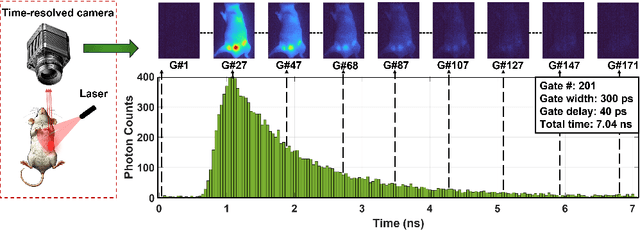

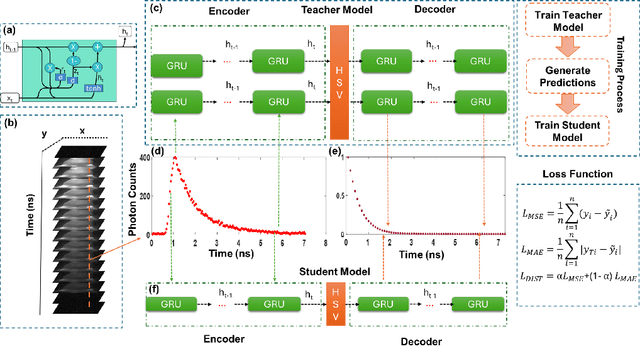
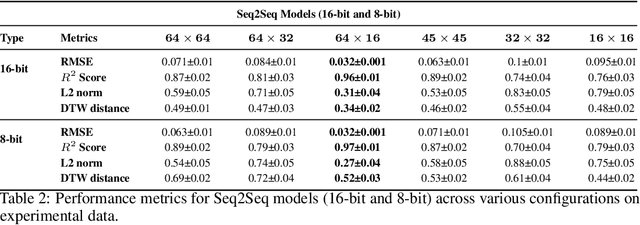
Abstract:Fluorescence lifetime imaging (FLI) is an important technique for studying cellular environments and molecular interactions, but its real-time application is limited by slow data acquisition, which requires capturing large time-resolved images and complex post-processing using iterative fitting algorithms. Deep learning (DL) models enable real-time inference, but can be computationally demanding due to complex architectures and large matrix operations. This makes DL models ill-suited for direct implementation on field-programmable gate array (FPGA)-based camera hardware. Model compression is thus crucial for practical deployment for real-time inference generation. In this work, we focus on compressing recurrent neural networks (RNNs), which are well-suited for FLI time-series data processing, to enable deployment on resource-constrained FPGA boards. We perform an empirical evaluation of various compression techniques, including weight reduction, knowledge distillation (KD), post-training quantization (PTQ), and quantization-aware training (QAT), to reduce model size and computational load while preserving inference accuracy. Our compressed RNN model, Seq2SeqLite, achieves a balance between computational efficiency and prediction accuracy, particularly at 8-bit precision. By applying KD, the model parameter size was reduced by 98\% while retaining performance, making it suitable for concurrent real-time FLI analysis on FPGA during data capture. This work represents a big step towards integrating hardware-accelerated real-time FLI analysis for fast biological processes.
Amortized Bayesian Workflow (Extended Abstract)
Sep 06, 2024



Abstract:Bayesian inference often faces a trade-off between computational speed and sampling accuracy. We propose an adaptive workflow that integrates rapid amortized inference with gold-standard MCMC techniques to achieve both speed and accuracy when performing inference on many observed datasets. Our approach uses principled diagnostics to guide the choice of inference method for each dataset, moving along the Pareto front from fast amortized sampling to slower but guaranteed-accurate MCMC when necessary. By reusing computations across steps, our workflow creates synergies between amortized and MCMC-based inference. We demonstrate the effectiveness of this integrated approach on a generalized extreme value task with 1000 observed data sets, showing 90x time efficiency gains while maintaining high posterior quality.
Amortized Bayesian Multilevel Models
Aug 23, 2024



Abstract:Multilevel models (MLMs) are a central building block of the Bayesian workflow. They enable joint, interpretable modeling of data across hierarchical levels and provide a fully probabilistic quantification of uncertainty. Despite their well-recognized advantages, MLMs pose significant computational challenges, often rendering their estimation and evaluation intractable within reasonable time constraints. Recent advances in simulation-based inference offer promising solutions for addressing complex probabilistic models using deep generative networks. However, the utility and reliability of deep learning methods for estimating Bayesian MLMs remains largely unexplored, especially when compared with gold-standard samplers. To this end, we explore a family of neural network architectures that leverage the probabilistic factorization of multilevel models to facilitate efficient neural network training and subsequent near-instant posterior inference on unseen data sets. We test our method on several real-world case studies and provide comprehensive comparisons to Stan as a gold-standard method where possible. Finally, we provide an open-source implementation of our methods to stimulate further research in the nascent field of amortized Bayesian inference.
Detecting Model Misspecification in Amortized Bayesian Inference with Neural Networks: An Extended Investigation
Jun 06, 2024

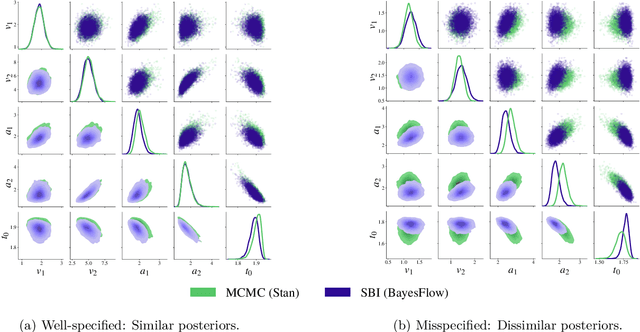

Abstract:Recent advances in probabilistic deep learning enable efficient amortized Bayesian inference in settings where the likelihood function is only implicitly defined by a simulation program (simulation-based inference; SBI). But how faithful is such inference if the simulation represents reality somewhat inaccurately, that is, if the true system behavior at test time deviates from the one seen during training? We conceptualize the types of such model misspecification arising in SBI and systematically investigate how the performance of neural posterior approximators gradually deteriorates as a consequence, making inference results less and less trustworthy. To notify users about this problem, we propose a new misspecification measure that can be trained in an unsupervised fashion (i.e., without training data from the true distribution) and reliably detects model misspecification at test time. Our experiments clearly demonstrate the utility of our new measure both on toy examples with an analytical ground-truth and on representative scientific tasks in cell biology, cognitive decision making, disease outbreak dynamics, and computer vision. We show how the proposed misspecification test warns users about suspicious outputs, raises an alarm when predictions are not trustworthy, and guides model designers in their search for better simulators.
Towards Context-Aware Domain Generalization: Representing Environments with Permutation-Invariant Networks
Dec 15, 2023Abstract:In this work, we show that information about the context of an input $X$ can improve the predictions of deep learning models when applied in new domains or production environments. We formalize the notion of context as a permutation-invariant representation of a set of data points that originate from the same environment/domain as the input itself. These representations are jointly learned with a standard supervised learning objective, providing incremental information about the unknown outcome. Furthermore, we offer a theoretical analysis of the conditions under which our approach can, in principle, yield benefits, and formulate two necessary criteria that can be easily verified in practice. Additionally, we contribute insights into the kind of distribution shifts for which our approach promises robustness. Our empirical evaluation demonstrates the effectiveness of our approach for both low-dimensional and high-dimensional data sets. Finally, we demonstrate that we can reliably detect scenarios where a model is tasked with unwarranted extrapolation in out-of-distribution (OOD) domains, identifying potential failure cases. Consequently, we showcase a method to select between the most predictive and the most robust model, circumventing the well-known trade-off between predictive performance and robustness.
Fuse It or Lose It: Deep Fusion for Multimodal Simulation-Based Inference
Nov 17, 2023Abstract:We present multimodal neural posterior estimation (MultiNPE), a method to integrate heterogeneous data from different sources in simulation-based inference with neural networks. Inspired by advances in attention-based deep fusion learning, it empowers researchers to analyze data from different domains and infer the parameters of complex mathematical models with increased accuracy. We formulate different multimodal fusion approaches for MultiNPE (early, late, and hybrid) and evaluate their performance in three challenging numerical experiments. MultiNPE not only outperforms na\"ive baselines on a benchmark model, but also achieves superior inference on representative scientific models from neuroscience and cardiology. In addition, we systematically investigate the impact of partially missing data on the different fusion strategies. Across our different experiments, late and hybrid fusion techniques emerge as the methods of choice for practical applications of multimodal simulation-based inference.
Sensitivity-Aware Amortized Bayesian Inference
Oct 23, 2023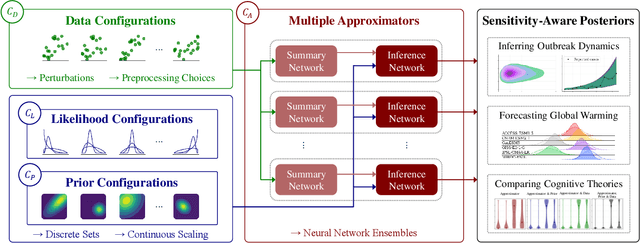
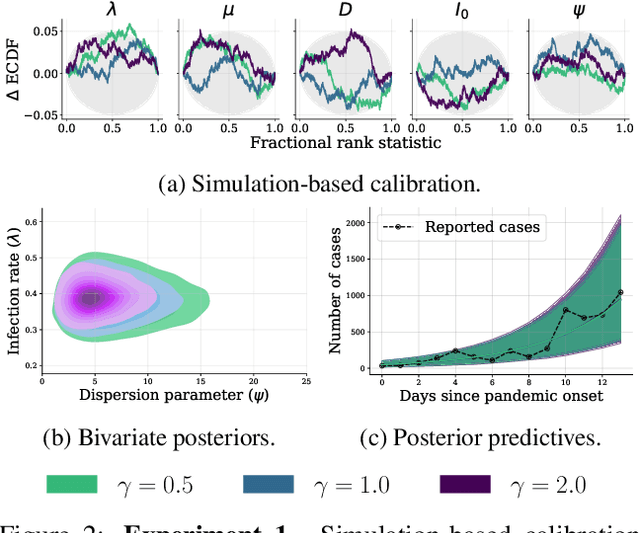


Abstract:Bayesian inference is a powerful framework for making probabilistic inferences and decisions under uncertainty. Fundamental choices in modern Bayesian workflows concern the specification of the likelihood function and prior distributions, the posterior approximator, and the data. Each choice can significantly influence model-based inference and subsequent decisions, thereby necessitating sensitivity analysis. In this work, we propose a multifaceted approach to integrate sensitivity analyses into amortized Bayesian inference (ABI, i.e., simulation-based inference with neural networks). First, we utilize weight sharing to encode the structural similarities between alternative likelihood and prior specifications in the training process with minimal computational overhead. Second, we leverage the rapid inference of neural networks to assess sensitivity to various data perturbations or pre-processing procedures. In contrast to most other Bayesian approaches, both steps circumvent the costly bottleneck of refitting the model(s) for each choice of likelihood, prior, or dataset. Finally, we propose to use neural network ensembles to evaluate variation in results induced by unreliable approximation on unseen data. We demonstrate the effectiveness of our method in applied modeling problems, ranging from the estimation of disease outbreak dynamics and global warming thresholds to the comparison of human decision-making models. Our experiments showcase how our approach enables practitioners to effectively unveil hidden relationships between modeling choices and inferential conclusions.
 Add to Chrome
Add to Chrome Add to Firefox
Add to Firefox Add to Edge
Add to Edge